Today's Tarot for Jim Morrison
| The Creative Process spread is designed specifically to peer into the nature of a project or creative undertaking, and shine a spotlight on the evolution of its parts. The William Blake Tarot explores the mystical vision and artistry of the renowned English painter and poet. Through rich interpretations focused on creative undertakings, it has long been the deck of choice for artists, writers, musicians, and thinkers. For more information about this deck, or to buy your own personal copy, go to www.blaketarot.com.
|
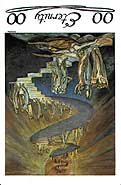 | The card in the middle represents the creative force behind the project, be it a person, organization, or other entity. Eternity, when reversed: The intervention of transcendent forces in the everyday world. The great are brought low and the petty are elevated. Obsession with the passage of time and the immanence of death. Being overwhelmed by the repetition of evil and mediocrity, and withdrawing from the world. Cynicism and nihilism driven by regret over past mistakes. |
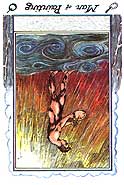 | The card on the top represents imagination - the prophetic image that stems from the creative force of the previous card to initiate the project. This is the poetry or voice of the undertaking. Man of Painting, when reversed: The need to dominate the situation. Allowing theory to get in the way of pragmatics. Intoxication with a highly charged situation. Taking a dogmatic and self-indulgent approach. Obsessive focus on the task at hand. Bathing in the spotlight. In the creative process: Test and refine your ideas or product to see if it works as planned; be practical yet innovative. |
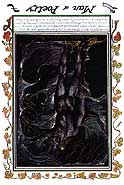 | The card on the left represents emotion - the feelings aroused by or surrounding the ideation of the project that takes place in the previous card. This is the music or scent of the undertaking. Man of Poetry, when reversed: Lack of tact and polish. Revealing truth without regard for personal consequences. Being driven by your ego to assert how things will be done. Rigidity and refusal to see alternate viewpoints. In the creative process: When you see the whole picture of your project, you can take charge to boldly direct it toward achieving its divine potential. |
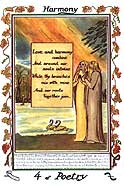 | The card on the bottom represents thought - the analytical process of organizing the project and capturing the emotional content of the previous card. This is the science or vision of the undertaking. Four of Poetry (Harmony): "Love and harmony combine / And around our souls entwine / While thy branches mix with mine / And our roots together join". Things are coming together beautifully. Giving thanks for an achievement or personal success. Celebrating a harvest, homecoming, or a job well done. Harmonious relationships with friends and family. Working together with a partner or sharing a special experience. In the creative process: The various elements and personalities involved in your project are interacting harmoniously, generating an appropriate sense of gratitude for what has been accomplished so far. |
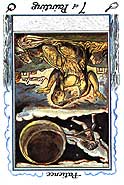 | The card on the right represents manifestation - the real work involved in completing the project, and the form it will take upon culmination. This is the painting or touch of the undertaking. Seven of Painting (Patience), when reversed: Refusing to wait for the situation to develop or ripen. Demanding immediate material assistance or reinforcements. Possible delays and slowdowns. Feeling uncertain or apprehensive about a tangible issue. Procrastination. Squandering your resources. In the creative process: Straining to speed things up only produces anxiety, so get a grip and wait for everything to unfold according to its own timing. |
|
|









